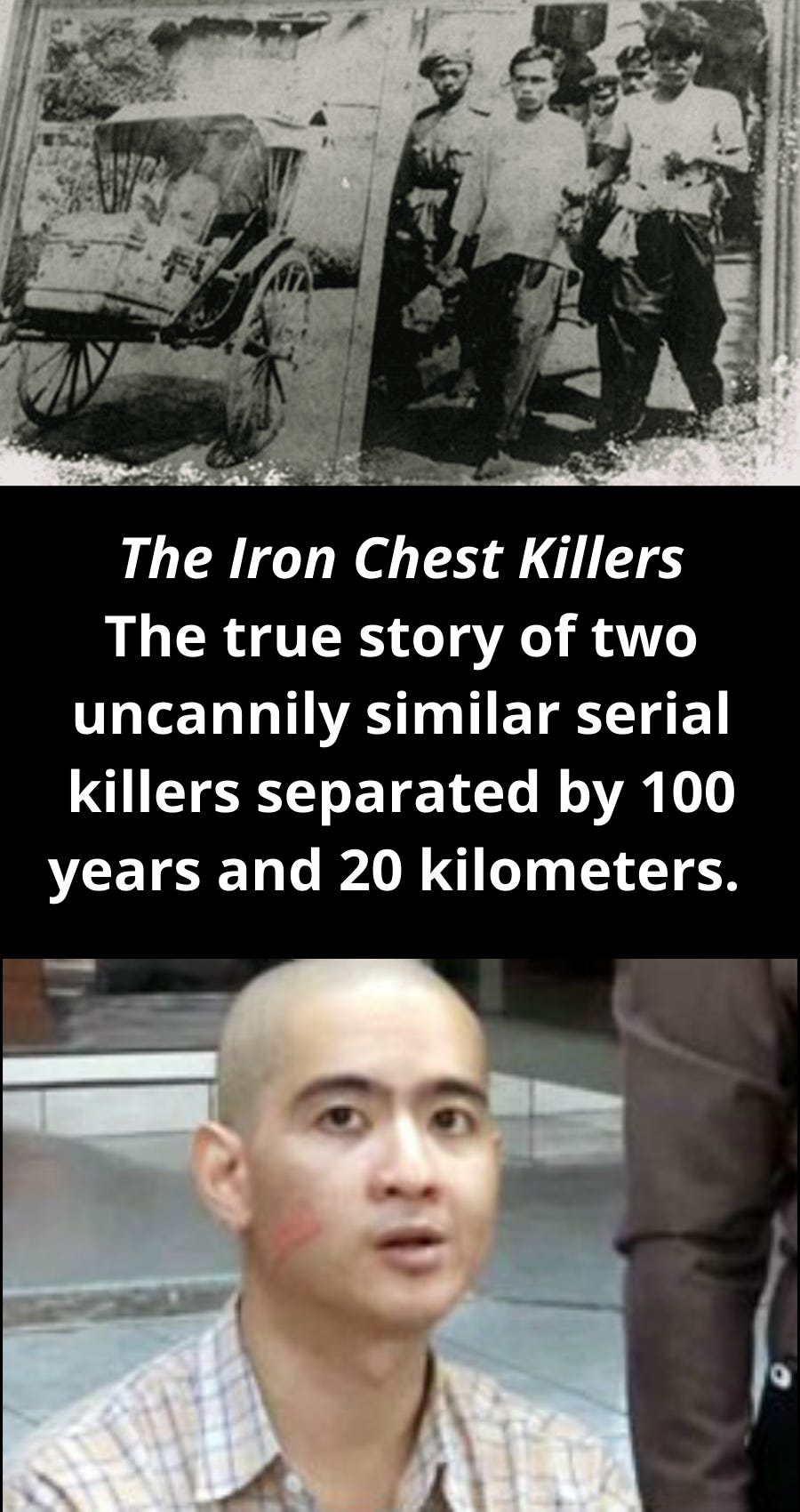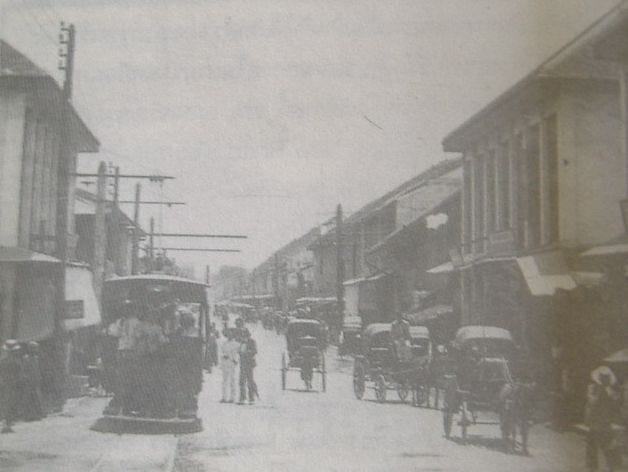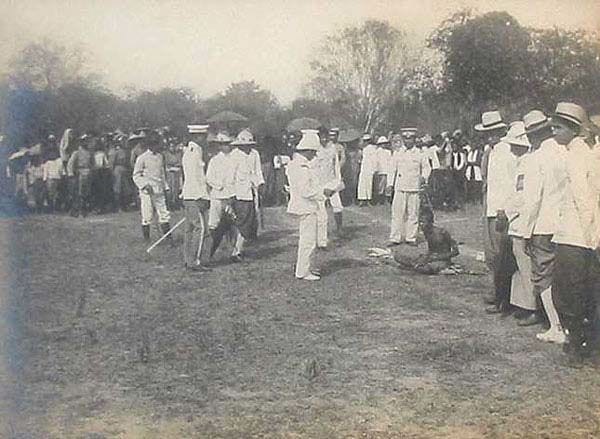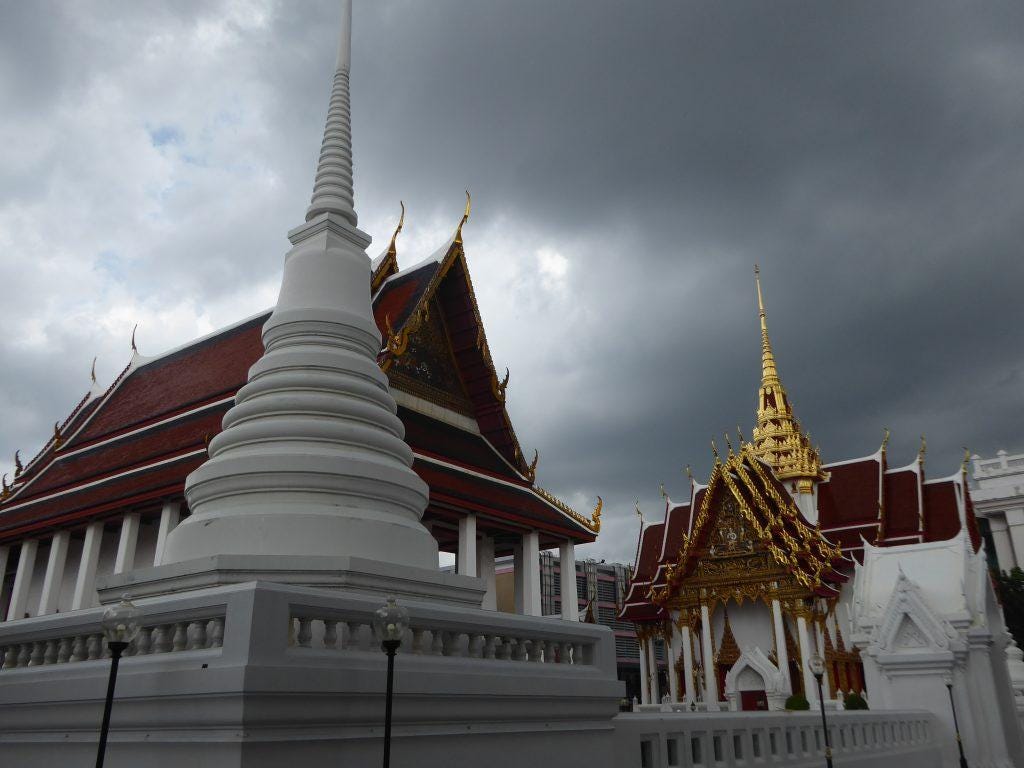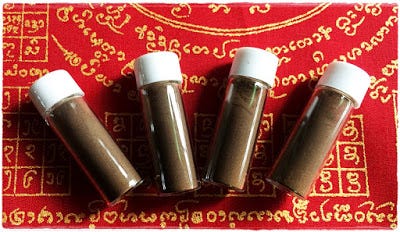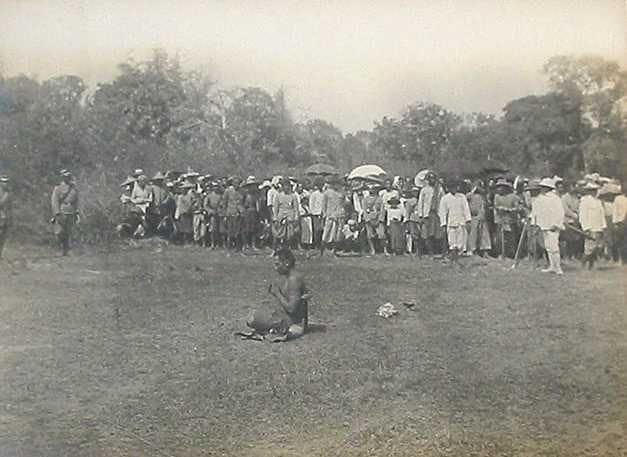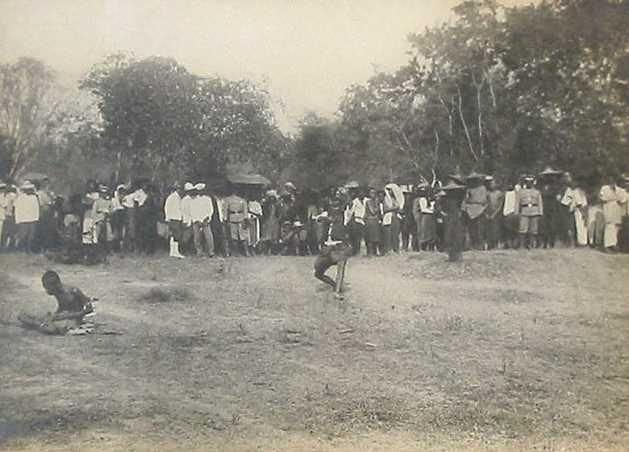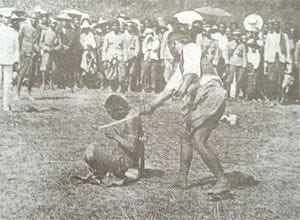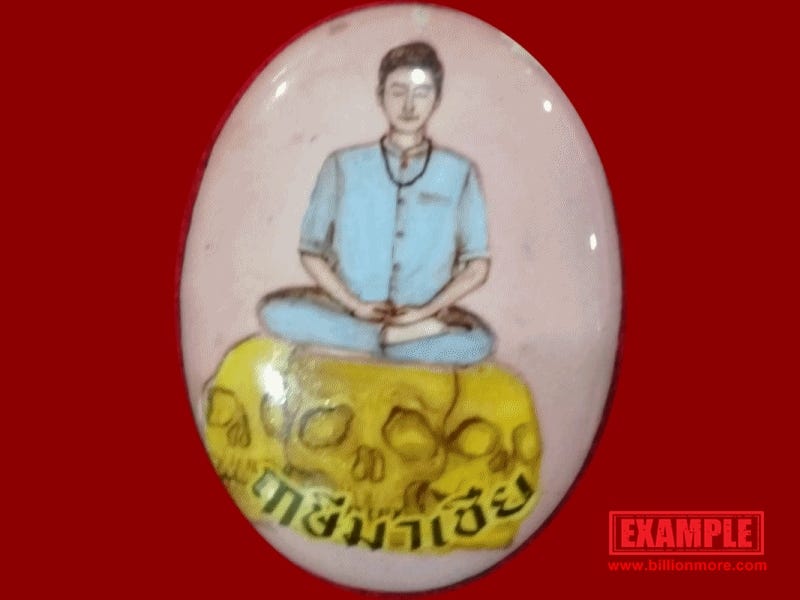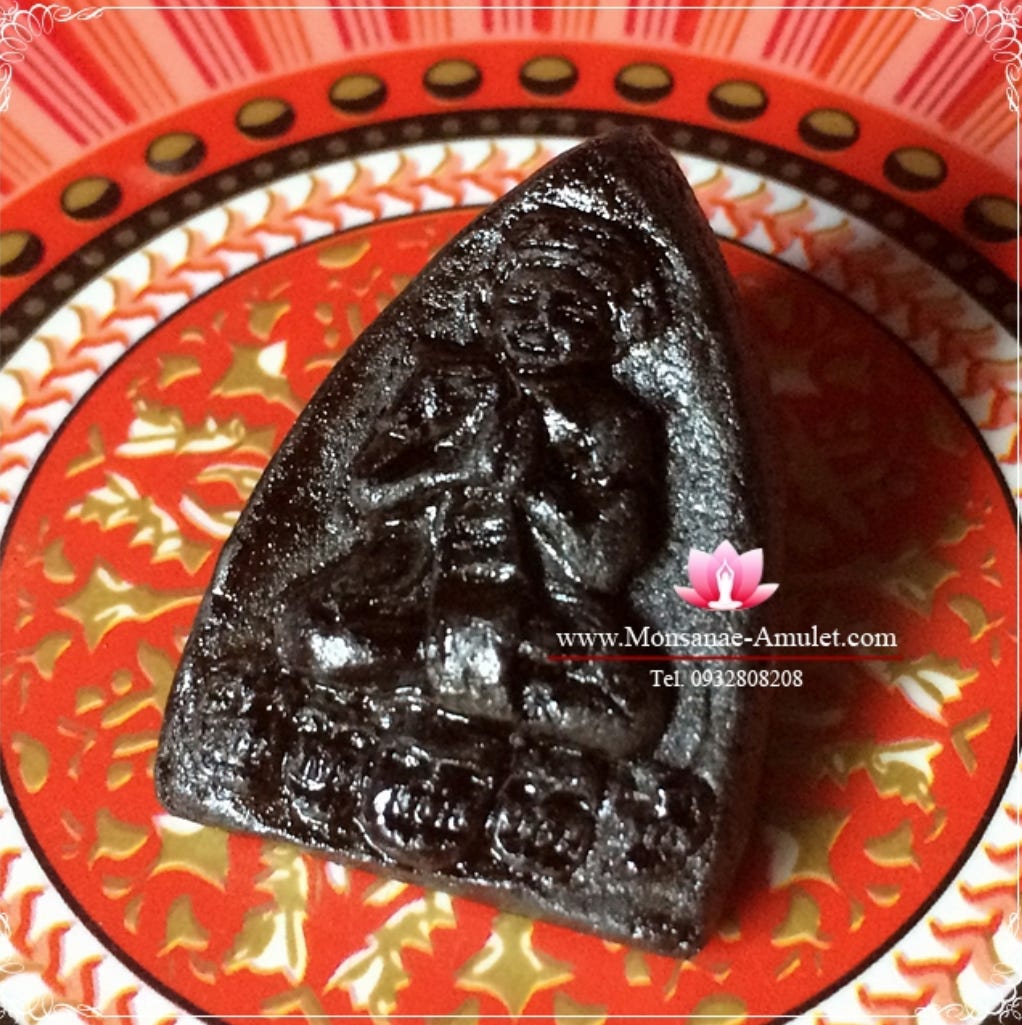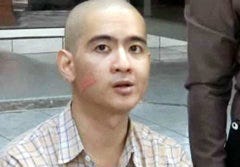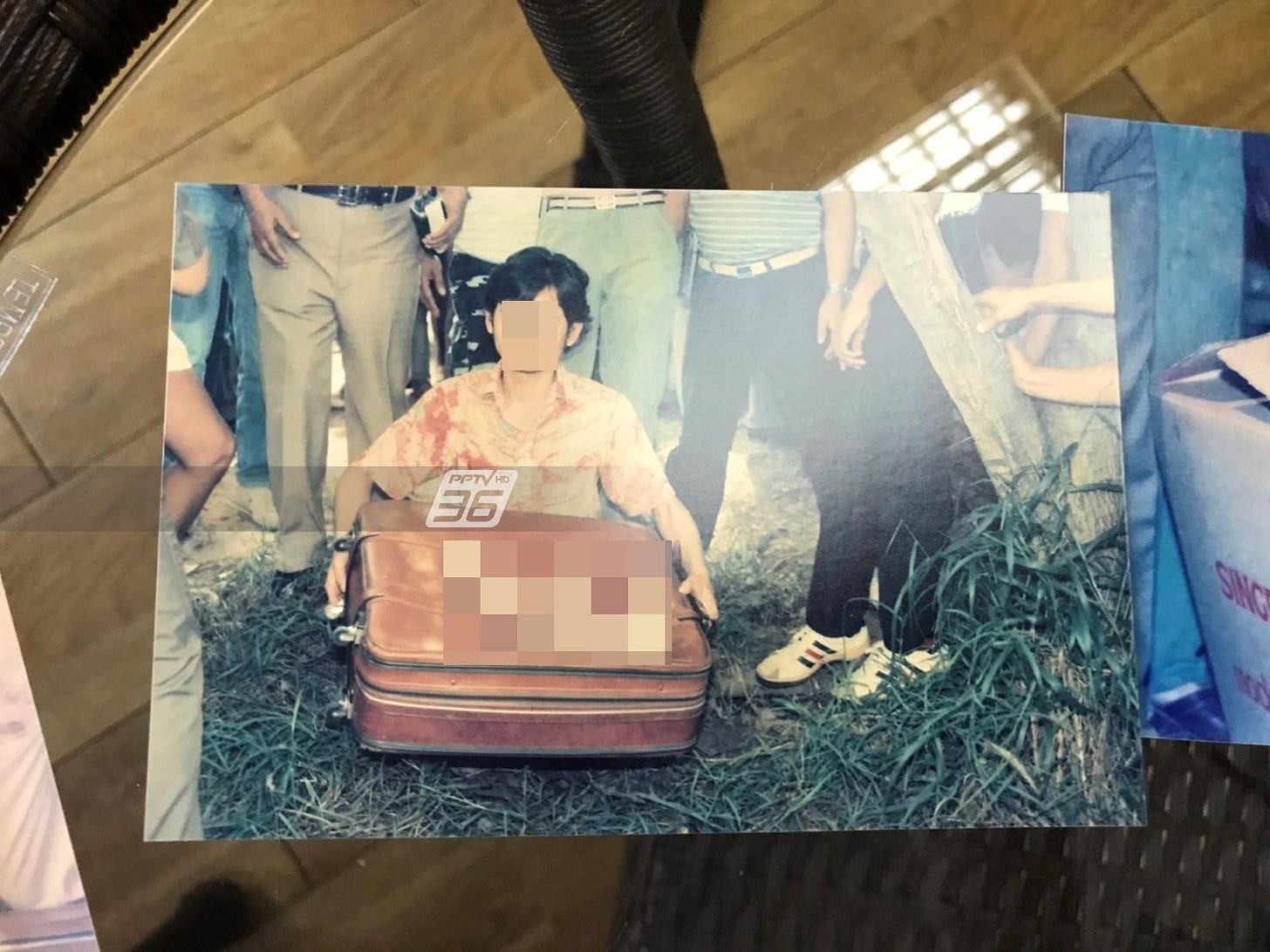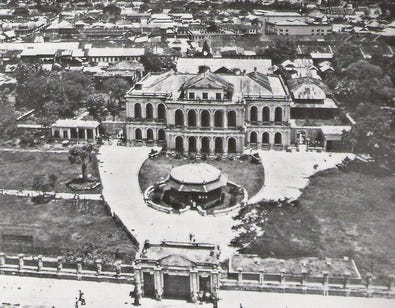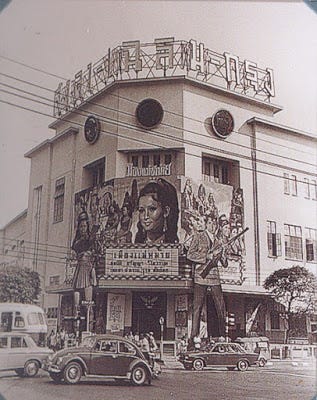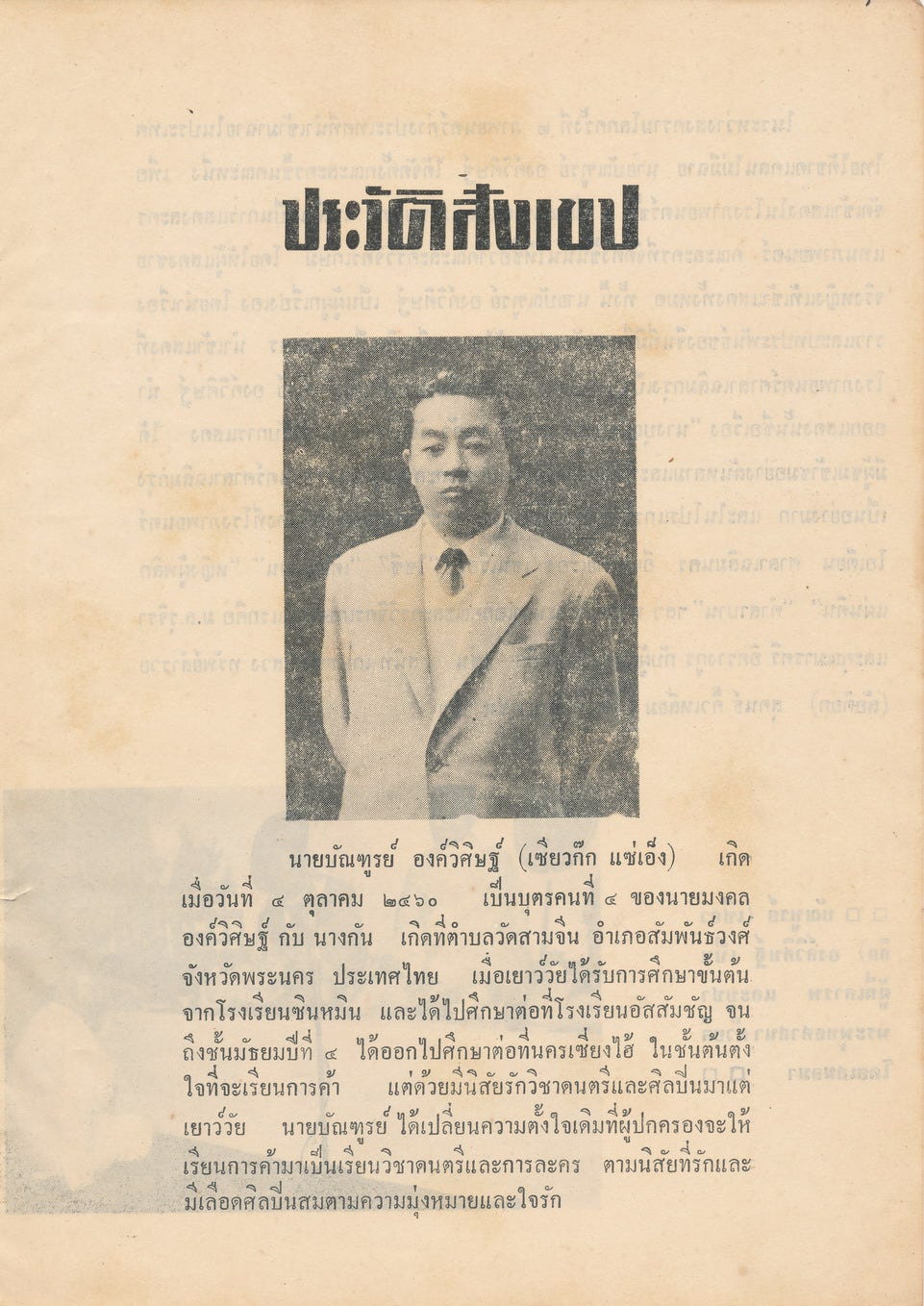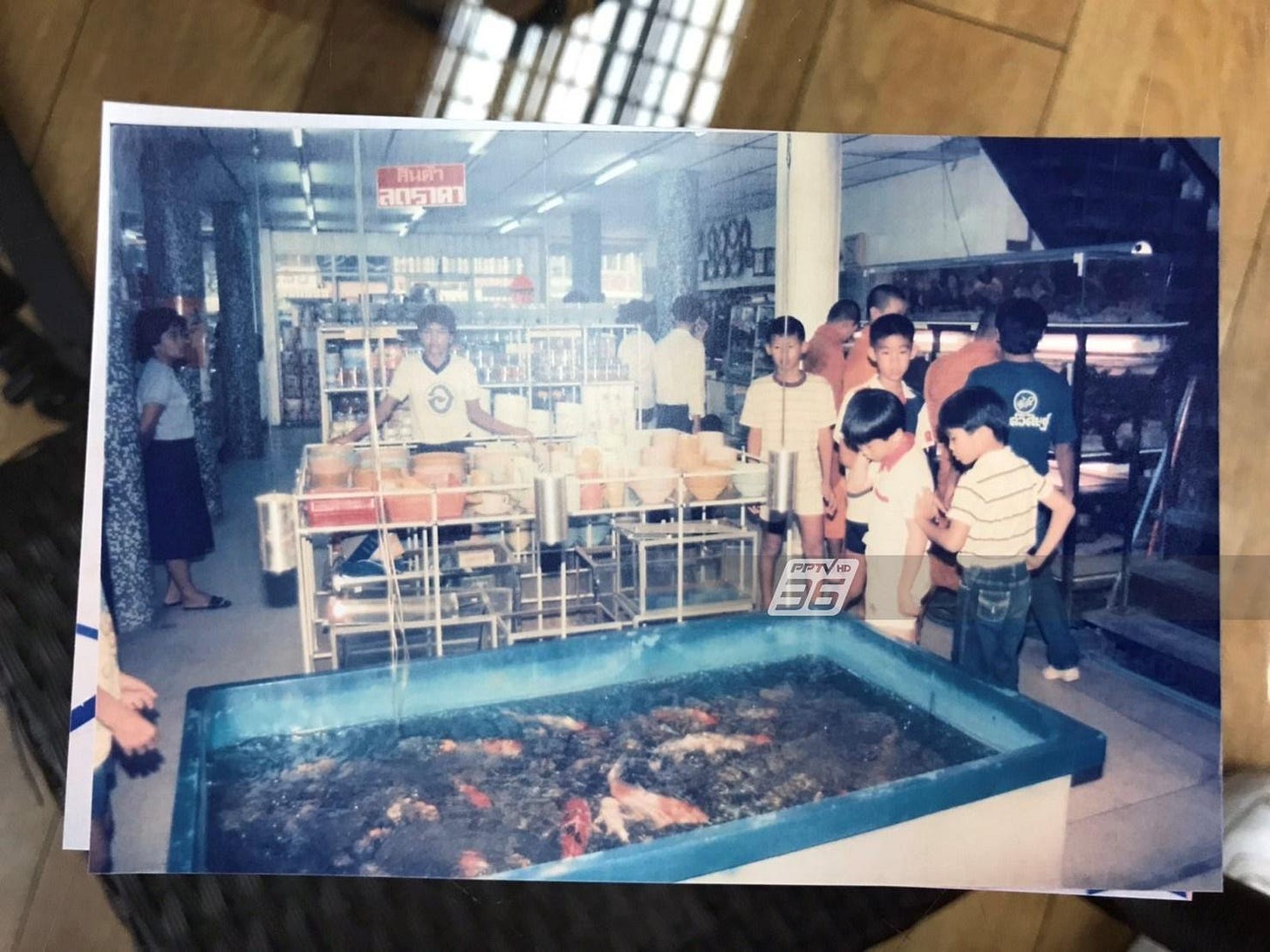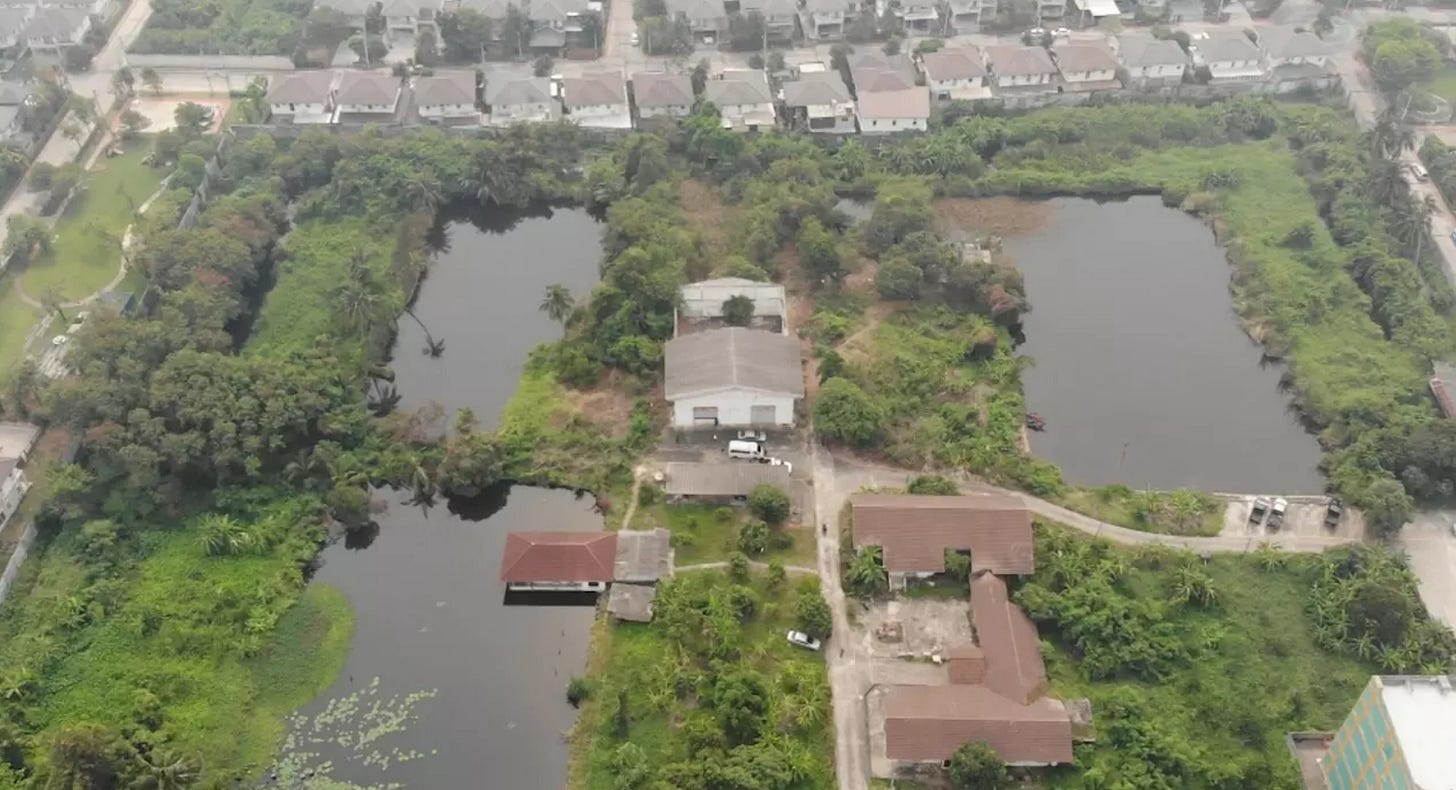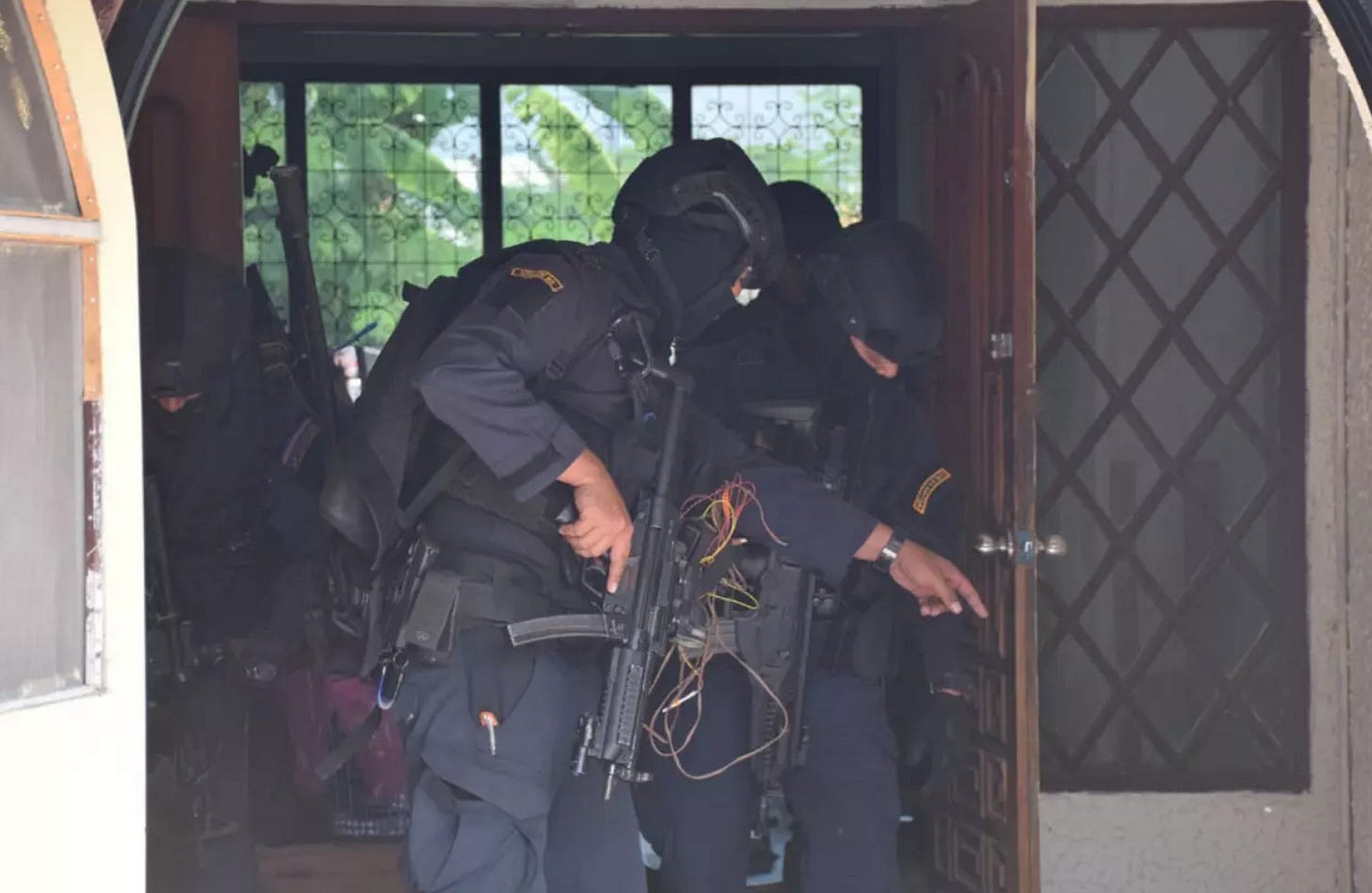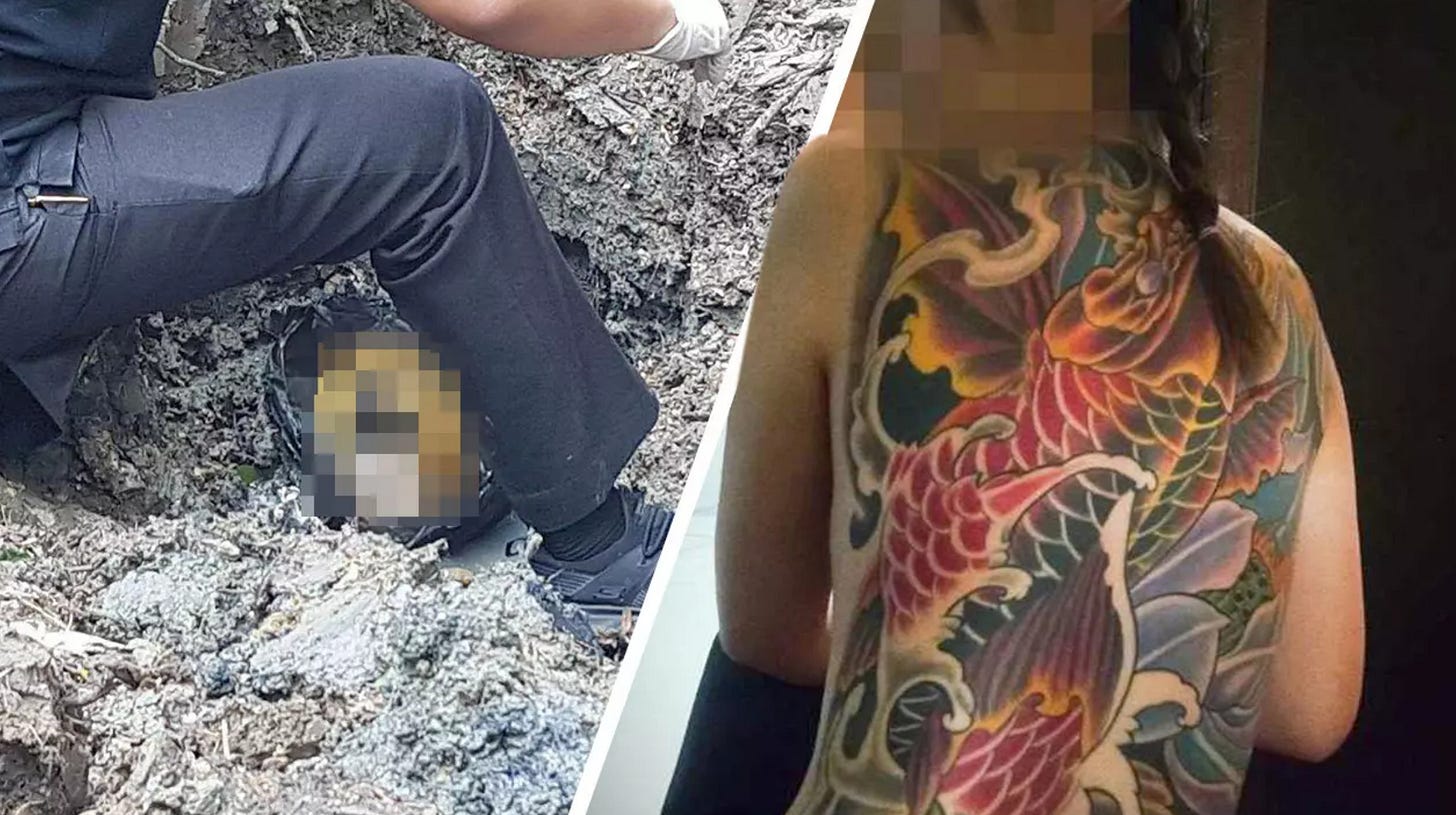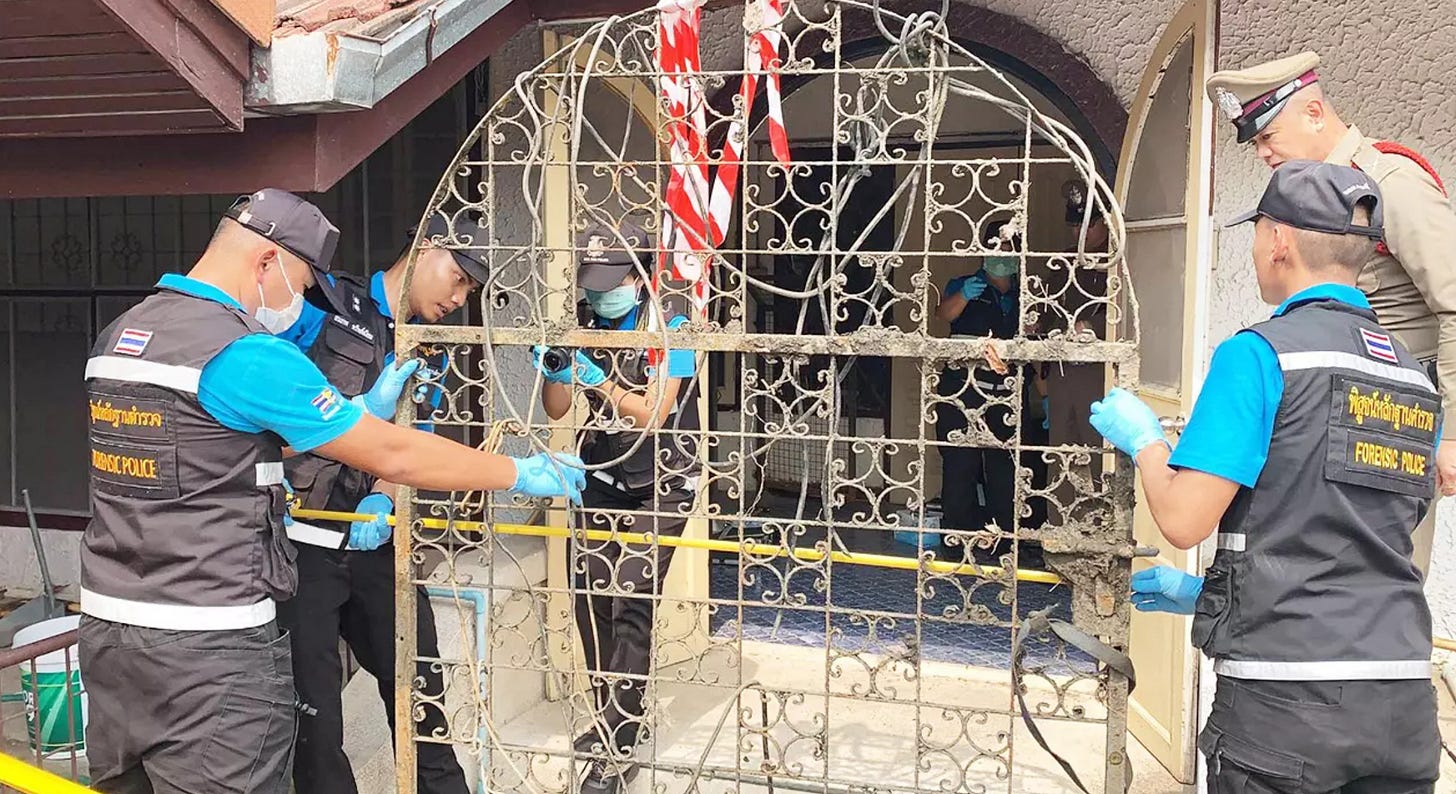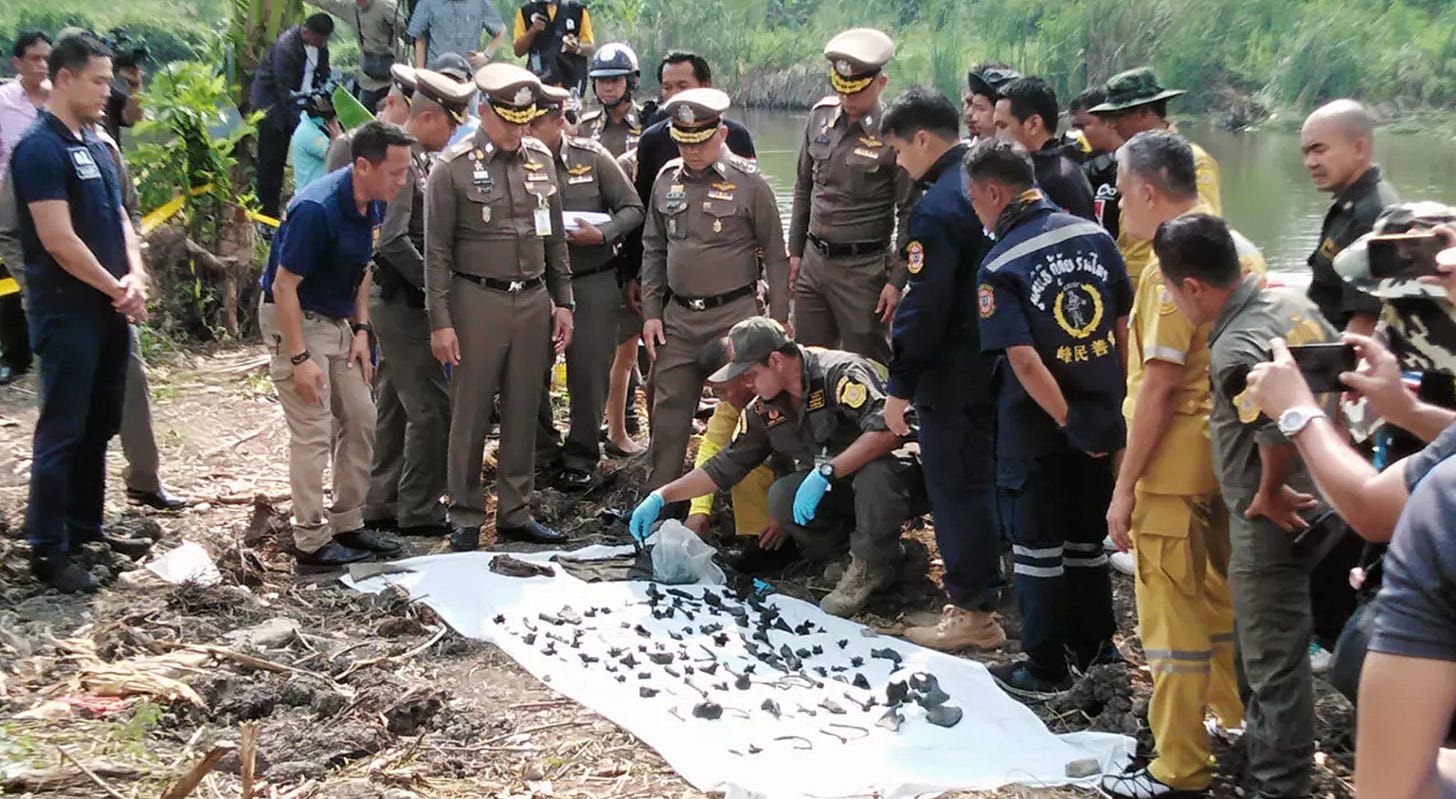The Iron Chest Killers: Boonpeng Heep Lek & Ice Heep Lek.
Two uncannily similar serial killers separated by 100 years and 20 kilometers.
On January 12th, 1918, exactly 102 years ago from the day this article was published, the body of Nong Prik was discovered in an iron chest in the Chao Phraya River. The culprit was a man nobody up until that point would have ever expected.
A man in saffron robes, Boonpeng Heep Lek.
It’s a story that echoes through time: in books, comics, movies, and in the grisly deeds of another serial killer who stands trial soon in 2021: Ice Heep Lek, a name the press gave that calls back to the original Iron Chest Killer.
Note: I made a helpful Google Map that shows where all the crimes and locations took place for both Boonpeng and Ice. You can access it here:
Sticks and stones will break my bones, but words will never hurt me.
What power do words have? And names?
It’s a question I thought about when researching the story of two Thai serial killers. Their murders and their personalities uncannily similar. Their collective crimes, an unknown number of murders each, took place only 20 kilometers from each other. The only thing that stood between them? One hundred years in time.
Surely you saw the headlines from 2020.
“Heinous crime: ‘Ice Metal Casket’ and the hidden bodies at his home”
“Horror case of ‘Ice Metal Casket’ continues”
“‘Ice Metal Casket’ gets 11 years for rape involving firearms”
They go on and on.
Especially in the Thai press.
Who is this “Ice Metal Casket”? It’s the nickname of Apichai Ongwisit (Thai: องค์วิศิษฐ์). A 40 year old serial killer who is suspected of killing at least 4 people and disposing of their bodies under mango trees, in shallow graves, and with his namesake: stuffing their remains in a “metal casket” and sinking it in his property’s pond.
Ice is his nickname, you know the kind that every Thai has. “Metal casket” is an English translation of หีบเหล็ก (heep lek), which more precisely translates as “iron casket/coffin/chest.”
Let’s call him by his Thai name from here on out then, and abandon the cheap English translation of “Ice Metal Casket.” Names have power, and names are important, especially for the story I tell below.
Apichai Ongwisit is known by all Thais simply as Ice Heep Lek.
He was detained for his crimes in January 2020. Ice Heep Lek is sitting in Thonburi Remand Prison awaiting the trial that will see him convicted for the crimes related to the 4+ bodies discovered buried and at the bottom of a pond at his Bangkok property.
For as heinous as Ice Heep Lek’s crimes are, and don’t worry, I will get to them in full detail -- but to just give you a taste, he killed a 22 year old girlfriend by forcing her into an iron chest to sleep, because he loved her of course, and didn’t want her to flee, and it’s in that iron chest where she suffocated -- he is not the only “Heep Lek” killer in Thailand’s history.
Let’s take a big step back in time. One hundred years to a different Thailand, in fact, not Thailand at all, but the Kingdom of Siam under the reign of Vajiravudh or King Rama VI.
To anchor you in that time:
Don Mueang Airport’s construction was started in 1914. Yes, that’s how old that relic is.
Chulalongkorn University, the crown jewel of Thai education, was founded in 1917.
And on August 19th, 1919, the last public execution by Siamese beheading -- and yes, they had their own method, which will be described in detail later in this tale -- was performed on Soi 23 Sukhumvit.
At this time, Soi 23 Sukhumvit was a remote, weedy, undeveloped corner of Krungthep. High rise condos and Soi Cowboy were not on the minds of the crowds that gathered to witness the punishment that awaited the legendary man who plays a central role in this story: Boonpeng Heep Lek, the Iron Chest Killer (บุญเพ็งหีบเหล็ก).
This is the first Heep Lek (iron chest) of Thai history and lore, whose namesake comes from stuffing his dismembered victims into iron chests (one of his pictured above) and sinking them in the rivers and canals of Bangkok.
So who are these two Heep Leks, these two Iron Chest Killers? What are their stories? How do their crimes echo across Thailand’s long 20th century into the 21st?
And whose story should I tell first?
Should I start with Ice Heep Lek, a man facing trial in the coming weeks of 2021?
You’ll see this man’s name in the headlines more and more in the coming weeks and months. Ice, as he’s known, was born to immense wealth and privilege, whose grandfather was a star on the Thai silver screen in the 1950’s, whose father built his fortunes running the Ongwisit Market in Bang Khae district. A father who also happened to murder and dismember an 18 year old girl.
Ah, I’m getting ahead of myself here.
So many details, it’d be a shame if I glossed over them.
Or should I start in the past with Boonpeng Heep Lek? A monk whose seductive charms earned him the devotion of countless women who willingly became his love slaves, who murdered his victims while in the robe, whose head was lopped off on Soi 23 Sukhumvit — but only after a storied failed first attempt by the executioner?
The past or the present? Where do I begin?
As I write this, I really can’t decide, and being absolutely transparent in my process, I’m telling you now how I will: by coin flip.
Heads is Ice Heep Lek and the present; tails is Boonpeng Heep Lek and the past.
Easy enough. I’ll flip the coin now.
Tails it is. Let’s start then on the back-end of time and later leap forward to the present to tell the story of the two iron chest killers.
The fair and handsome monk: Boonpeng Heep Lek, the Iron Chest killer

About 125 years ago, the exact date murky, a boy was born in Tha Uthen, a district that rests against the banks of the Mekong River in Nakhon Phanom province. His father was Chinese, his mother Lao. His name? Boonpeng.
When he was five years old, and for reasons that remain unknown, his parents delivered the boy to his maternal grandparents who lived in Bang Khun Phrom, a sliver of a neighborhood in the Phra Nakhon district of Bangkok, which hugs the eastern side of the Chao Phraya River.
Grandpa Suk (ตาสุก - Dtaa Suk) and Grandma Pian (ยายเพียร - Yai Pian) raised the boy the best they could.
They recruited Boonpeng to help them in their vegetable gardens, but he hated getting his hands dirty. He was a bookish and devoted type, and enjoyed his days studying with monks at Wat Thewarat Kunchorn (วัดเทวราชกุญชร), a temple on the eastern banks of the Chao Phraya River and about a 15 minute, 1.5 kilometer walk from his grandparent’s home.
That was all well and good and encouraging. But another temple won young Boonpeng’s heart and seduced him into the dark arts. This was Wat Phai Kaw (วัดไผ่เคาะ, this temple no longer stands), the Bamboo Knock Temple, where he was initiated into Thai black magic by the temple’s undertaker, a man known only as Grandpa Plai (ตาไปล่).
The undertaker Grandpa Plai was well-versed in the dark arts. His abilities ranged from fortune-telling to defeating ghosts and evil spirits. But what interested young Boonpeng the most was the magic of “twin” potions (ยาแฝด).
Despite the name, the old and ancient rituals of making these “twin” potions had nothing to do with actually giving birth or making twins in a mother’s womb. The ancient practice was to make charms and potions, which are given to bewitch another into love.
Knowledge of the practice was guarded and concealed closely, only revealed to initiates for fear that it would be damaging in the wrong hands. One of the ancient ways of this twin-making magic, which Boonpeng likely learned, is performed as follows:
Bathe in a tub, scrub the body thoroughly. Wait for the water to settle then spoon some of the water out of the tub. Mix the water with a musk and work it into a ball of wax. Swallow the ball of wax, let it settle in the stomach, and watch for it when defecating. Take the ball of wax after and wash it and set it afire. Cast a spell over it that those who wish to love you will until the day of their death.
You then prepare a food with what remains, mixed with other sacred materials. Some recipes use blood, ashes of dead bodies. The potion is given to the object of your love and another spell is cast when they eat it. This causes infatuation and they are unable to resist you after.
There are several other methods of making this magical potion, but this was most interesting to me in my research.
Boonpeng completed his studies in the occult with Grandpa Plai at the Bamboo Knock Temple. He was adept at crafting magical objects, potions, and spirit-dolls, fortune telling, and of course, the black magic powers to dominate another’s affections.
I will pause here for a moment.
I know that some readers might find all of this too much, unbelievable, woo-woo hocus pocus. I relay these details for two reasons: first, they are in the accounts that have passed down in Thai sources, and I only wish to get the information out in English. Second, even if we remain skeptical of the efficacy of Thai magic, the people at the time believed in its power, and more importantly, feared its power, and this was one way that Boonpeng built his infamy and prowess with his future followers.
This second point is critical to the story. For Boonpeng was not an ordinary monk. In fact, when he was 20 years old, he was ordained at Wat Thewarat Kunchorn. But he was quickly expelled from that institution. Why? Because of his reputation for dabbling in the dark arts, and the rumors that swirled about him.
Women giving their bodies to him, becoming his love slaves. He gambled voraciously. And he was feared for his black magic.
The gossip was likely founded in truth.
So what does the young, handsome Boonpeng do after being expelled?
He walked down the road about 3 kilometers to Wat Suthat Thepwararam (วัดสุทัศนเทพวราราม). He tried his luck there. Young Boonpeng wanted to be accepted at a temple so that he could continue his cloistered life, build his following, and do as he pleased with the protection of the saffron robe.
But this temple wasn’t so far away from the temple where he was just expelled. The abbot of Wat Suthat Thepwararam was well-aware of the budding Boonpeng’s shady reputation. So he denied his admission to the temple.
Of course, Boonpeng persisted. And persisted. And persisted.
Finally, the abbot of Wat Suthat Thepwararam relented. He allowed Boonpeng to ordain and take residence at his temple, which is where Boonpeng called home for the next 9 years.
This is where the story takes a turn from the primitive games of black magic and spells to the very real dark place of murder and greed.
Boonpeng set up a nice little life for himself at Wat Suthat Thepwararam. A devoted following developed around him. Mostly women. Mostly beautiful, and if they weren’t comely to the eye, then they were rich. If they were men, then they did anything their master told them -- even so far as help Boonpeng to dispose of bodies.
But I’m getting ahead myself.
What did life at the temple look like for Boonpeng? What did he do on the daily?
It’s hard to say. Records are scant. But what comes down through time is clear: He got pissed up boozing with his followers; he opened up a casino at the temple and gambled away the fortunes he pilfered from his followers. He caused havoc with the other monks: fights and discontent built up around him.
But oddly he was not expelled. Not for a whole 9 years.
Why was he allowed to operate like this?
I’d wager that it was because he had popular support among the villagers and locals around the temple.
He impressed nearly all of them. Anybody who came in contact with Boonpeng wanted his charms and potions, which were known to be incredibly effective. His room became a popular place for his “rituals of love” where he’d sneak away with his female followers deep into the night. It’s said that every young woman, both near and far, was willing to indulge her body to his whims. He’d stun them, either with his magic or his charisma, you pick, and they’d become slaves of lust under his spell.
Some women he just used for erotic delight, but others he used for the riches that they gladly laid upon his feet. His wealth and prestige grew by the day, the lot of it taken from his followers. But Boonpeng was a gambling addict and he’d wager their wealth away, only to turn to another victim and charm their gold and jewels into his hands.
Some sources say Boonpeng had a sadist streak. A brutal lover. Young women started to disappear around Boonpeng, a phenomenon very similar to Ice the Iron Chest killer whose story comes a bit later. And this is where the rumors started to swirl with villagers.
Then a young woman who was an erotic playmate of Boonpeng’s disappeared one day along with an iron chest that was kept in his room. Other young women disappeared, along with the iron chests. One by one. One by one.
The rumors multiplied. But the disappearances couldn’t be pinned on Boonpeng. At least not yet. In fact, such a crime was so far beyond the realm of possibility in the minds of the villagers and locals and devotees, that a man of the robe could do such a thing: murder a young woman, steal her valuables, chop up her body, stuff it into an iron chest and sink it to the bottom of the river.
It just could never have been.
Then in 1917, still in the reign of King Rama VI, in the Khlong Bangkok Noi canal, an iron chest was discovered. When the locals opened it they couldn’t believe what was inside: the decaying corpse of a middle-aged man, later identified as Mr. Nai Lom.
Mr. Lom was a very wealthy and successful jeweler. Boonpeng welcomed Mr. Lom to his room and he wanted to buy diamonds from the jeweler. But when Mr. Lom arrived, it didn’t take long for Boonpeng to execute his sinister plan. He killed the jeweler with the help of his followers and stole the diamonds and gems that Mr. Lom brought with him to sell.
Boonpeng was now left with a corpse. He instructed his student to cut up the man’s lifeless body and stuff him into an iron chest. They then hauled the iron chest on a “rot jek” (รถเจ๊กนำ) or rickshaw a whole 6 kilometers, no small feat in those days -- just imagine how nosy everybody was! -- across the other side of the Chao Phraya River, all the way to Khlong Bangkok Noi and sunk it into that canal (note: one source says that the body was disposed in a Bang Lamphu canal).
When the locals found the iron casket they were stunned. In fact, police didn’t even know how to investigate such a crime, for they’d never seen anything like it before. And to even suggest that the evil deed would have been done by the hand of a man in the robe would have been pure blasphemy in those times.
Simply put, Boonpeng got away with the murder scot-free. Nobody could have suspected him. And thus he continued bilking women, running his casino, and sating his most sadistic desires.
Everything changed on January 12th, 1918 -- exactly 102 years before this story was published to the very day.
A female corpse was found in an iron chest in the Chao Phraya River, her hands and feet bound with rope, her body wrapped in mosquito net, and 8 bricks placed inside to cause it to sink to the bottom of the river. Details that again line up in uncanny ways with the discoveries at Ice the Iron Chest Killer’s home in January 2020, which will be discussed later.
The victim’s name was Nong Prik, a millionaire who caught the eye of Boonpeng not for her youth or beauty, but for the gold and jewels and rings and bracelets that hung from her wrists and fingers and neck. One problem. Nong Prik had a husband, Khun Sittkdi, who ignored his wife in favor of his own mistresses.
Nong Prik fell hard for Boonpeng and visited him often. Soon her belly was swollen with his child. Boonpeng was to be a father, and as was the tradition at that time, Nong Prik told Boonpeng to leave the temple and come make a home with her and the child.
Boonpeng had other plans. For he didn’t have a true affection for Nong Prik. Not for her body, which was a wrinkled thing, nor her heart, but for her pile of riches.
Nong Prik persisted in her demand to get Boonpeng out of the temple and into her home to start their family. She told him that she’d give everything to him: houses, property, farmland, treasure chests of gold and gems.
The idea intrigued Boonpeng. He kept the option in the back of his mind even as he continued his own philandering with his pick of the most beautiful and erotic women of Siam.
Nong Prik persisted still, to the point that it disrupted Boonpeng’s own plans, which were now to marry a new woman. The young and beautiful Nong Tat.
Boonpeng sent a letter to Nong Prik asking her to visit him at his room in Wat Suthat Thepwararam. He needed to speak with her and return the 10 baht gold necklace (1 baht of gold is 14.71046 grams, with a value at publication of this article of roughly 27,400 Thai baht per baht of gold; an extraordinary amount for that time) that she’d loaned to him.
Nong Prik tucked the letter into her dresser and paid the visit to Boonpeng. This is when he struck in the secrecy of his cloister. According to the evidence passed down through time, Boonpeng strangled Nong Prik. He then instructed his students to cut up her body and place the remains in a large iron chest. His favorite hiding place for his grisly deeds.
Two of his disciples, a 19 year old young man and an older student, their names strangely similar: Mr. Charan and Mr. Charoen, hired a “rot jek”, the rickshaw, and hauled the body to Wat Sai Ma, a temple on the banks of the Chao Phraya River, but way up in Nonthaburi. The distance between the murder scene and where they disposed of the chest? 20 kilometers. The two students of Boonpeng carted the iron chest that far and dumped it in the Chao Phraya River.
The local villagers knew what had happened, so Boonpeng fled Wat Suthat, where he’d operated, murdered, and built his fortune over a 9 year period.
One anecdote I found said that Boonpeng went up to Ayutthaya to ordain there. There was a 7 day period between when Nong Prik disappeared and when locals in Nonthaburi discovered her body. So, that doesn’t give Boonpeng too much time to have make the journey all the way up to Ayutthaya and then back again to marry Nong Tat. It’s a mystery what Boonpeng was up to in those 7 days, but it’s clear that he was in hiding.
An iron chest was discovered by local villagers in Nonthaburi in the Chao Phraya River on January 12th, 1918. The body of dismembered woman was inside. Shocked beyond anything in their wildest nightmares, they took the iron chest to Nonthaburi police.
Again, the locals were stunned to find a body in such a state: human organs spilling out, the body cut into 8 pieces, hands and feet bound tight with rope, bricks weighing everything down. They’d never seen anything like it before.
The Nonthaburi police acted fast.
By the morning of January 14th, 1918, they ran a poster in the Bangkok Daily Mail asking for anybody who knew of a missing woman, kith or kin, to report immediately to the police.

Her mother had reported Nong Prik going missing to police already. When she saw the photo in the newspaper on January 14th, she knew who it was without knowing the details. She contacted local police and showed them the letter that she’d found tucked away in Nong Prik’s room.
This evidence is what police used to arrest Boonpeng.
Later that afternoon police located Boonpeng at the home of one Mrs. Bua, mother of Nong Tat, the beautiful young woman who Boonpeng had his eyes on, and who that very day had married. They arrested him at the home, which was on Thanon Ti Thong -- an historic little soi near where goldsmiths are renowned, and where Lao people settled in the past.
Boonpeng admitted to the murder of Nong Prik, there was little he could do to deny it. The letter was clearly written by his hand. And he also admitted to the murder of the wealthy jeweler, Mr. Nai Lom.
But locals and police had other cases of the dismembered bodies of young women discovered at the bottom of canals and rivers stuffed in iron chests. There were five others, in fact. Crimes so similar in execution that they would have had to been committed by Boonpeng’s hand.
But Boonpeng denied the other five until the very day he died. Some say that one of his students and accomplices, Mr. Charan, murdered the other girls. It’s a question that we’ll never have answers to.
But the fact remains: at least 7 people were found in iron chests sunk in water in the Bangkok area when Boonpeng was around.
His motives seemed to have been two-fold: on one hand, he lusted for gold and riches, which he stacked up in his cloister at the temple and gambled away at night. On the other hand, he was a cruel sadist and insatiable lover. Some claim that when he abused his victims he’d go too far and they’d die by his hand. Others say he just killed them for their gold.
Mr. Charan and Mr. Charoen were co-defendants in the case of Nong Prik. The two were monks ordained at Wat Suthat and disciples of Boonpeng. Their fates are unknown, as they were never mentioned again.
We do know what happened to Boonpeng, however.
The court found Boonpeng guilty of murder in the deaths of Nong Prik and Mr. Nai Lom on August 12th, 1919.
He was scheduled to be executed in public by Siamese beheading on August 19th, 1919 at Wat Pha Si, a tax collection temple located in the Watthana district of Bangkok, Soi 63 Sukhumvit, better known as Ekkamai today. Although it’s a bustling center of Bangkok life now, this was a remote, weedy area 100 years ago.
The execution was attended by a large, roaring crowd. However, none of his family -- not his mother, nor father, nor grandparents, nor his new wife Nong Tat -- none of them attended the beheading. The case of Boonpeng and his grisly crimes had spread throughout Siam. They were particularly notorious because he was a man of the robe.
The method of execution was Siamese beheading. To be clear, the ancient Thais had their own particular ritual and method of beheading that was practiced for centuries.
There's an account of a beheading witnessed by P.A. Thompson at the end of the 19th century in Siam. Some salient details summarized from his report:
Executions and beheadings are a rare form of punishment, but when they happen, they are attended by the public. The condemned man is handed over to monks, who give him a last sermon. They ask him what he wishes for a last meal. Often, they're given opium.
The executioners plant a bamboo stick in the center of the stage, with a cross-piece about two feet from the ground. The condemned man is led there. He sits cross-legged on the ground with his back to the bamboo and his arms pressed against his sides, tied at the elbows to the cross-piece. The executioner kneels beside him, fills his ears with clay, and gives him incense to hold.
Then the executioner appears, dressed in brilliant crimson, a red band bound around his forehead, wielding the sword. The executioner goes and kneels about 20 meters away, waiting for the perfect moment to strike the condemned man.
The executioner then runs out onto the stage in front of the spectators. He wais the governor, raises his hands to the heavens, and dances around the stage on his tiptoes. Slowly moving towards the victim, and then in a sudden rush he severs the head.
After, the monks come out to chant over the dead man, and bring him to a grave already dug nearby. The head is stuck upon a pole and left as a warning to other evil-doers.
And from the photos that have been passed down of Boonpeng’s execution, this account seems spot on.
Of course, Boonpeng’s legend wouldn’t be complete without a twist at the end.
The executioner did his dance around the stage as the norm in a Siamese beheading. In a sudden dash he raised a white sword into the air and struck Boonpeng’s neck.
But nothing happened. The sword didn’t even break the skin.
The executioner flew off the handle and went into a rage. The crowd erupted, confused and shocked by what they witnessed.
The executioner watched as Boonpeng twitched his mouth, uttering some dark incantation. He saw that Boonpeng held something in his mouth. The executioner ordered Boonpeng to spit out whatever it was.
A black Buddha amulet landed on the ground. The executioner picked it up and placed it in the bamboo stuck in the ground in the center of the stage. It was a protection amulet, and according to all reports, it did the job.
But now with the black Buddha amulet out, Boonpeng was without protection. The executioner raised the white sword a second time and whacked his neck again. Success. Blood gushed from the neck in steady streams, like a spring that just broke from the earth.
Boonpeng’s execution by beheading was the last one ever state-sanctioned and performed in the country. On August 19th, 1919, the law was changed -- firing squad was the preferred method after Boonpeng’s head fell to the ground that day.
There are some reports that tell of what happened to his body after the execution. His relatives buried his bones in a pagoda near Wat Phasi. When he was cremated the tattoos on his back didn’t burn.
In 1994 a shrine for Boonpeng, now known as Uncle Boonpeng, was built at Wat Phasi. You can go and visit to this very day and ask for his blessings. A steady stream of devotees can be found bringing gifts and burning incense for the legendary killer, asking for good luck in love and riches.
A couple movies and old books were put out about Boonpeng Heep Lek.
Here’s a few posters and book covers. The films from 1967 and 1980 both are simply titled บุญเพ็งหีบเหล็ก (Boonpeng Heep Lek).
There’s even a cult following for his amulets.
They’re said to give great fortune in gambling, charming, luck, and prowess.
Maybe you’ll see Uncle Boonpeng at an amulet shop some day and pick one up for yourself.
The crimes of affluent psychopaths: Ice Heep Lek, the Iron Chest Killer
I’m not about to get biblical on you — I mean, I’m an expat in Thailand afterall, and I didn’t come here for the temples, if you catch my drift.
But old sayings are old for a reason. They’ve been tested by time and are still spoken even by the skeptic’s tongue until today.
Let’s pluck one from Shakespeare then, The Merchant of Venice:
The sins of the father are to be laid upon the children.
I promised you several times already to talk about a second killer. Apichai Ongwisit (ษฐ์องค์วิศิ), his birth name. But the name he earned in this life: Ice Heep Lek, the Iron Chest Killer.
He was given the same namesake as Boonpeng after his grisly deeds. He forced victims into iron chests, suffocating them, cutting their bodies up, weighing them down and tossing them into the waters deep.
But I won’t start Ice’s story with his crimes.
I should start with his father’s, for Ice’s motives might be explained by the sins of his father.
His father’s name name: Chalermchai Ongwisit (ฉลิมชัย องค์วิศิษฐ์), the heir of the prosperous and storied Ongwisit Market, long sold off since 1983.
And sold off for good reason. Chelermchai Ongwisit was no stranger to the murder of young girls and stuffing them in them in boxes. Except his choice wasn’t an iron case. It was a leather suitcase and TV boxes.
But I’m getting ahead of myself still. The story of the Ongwisit clan stretches further back in time, and twines ever so close to the same places where Boonpeng Heep Lek moved and murdered in his day.
A bit of history then. I swear, it does have a point.
In 1875 a palace was built by the order of King Chulalongkorn, Rama V, in the colonial style by an Italian architect by the name of Joachim Grassi. The location was in Wang Burapha, a subdistrict in Phra Nakhon.
Just right down the road from where Boonpeng Heep Lek grew up with his grandparents.
Buraphaphirom Palace, or the "East Palace", is was what the place was called.
After World War 2, the palace was abandoned. The heir prince, Somdej Wang Burapha, sold the grounds for a total of 12,020,000 baht. It was considered a fire sale at the time. To give perspective on current prices, 1 baht of gold was priced about 400 baht at that time, whereas now it's around 27,400 as of publication.
As far as the value of the land, one square wah now runs 900,000 baht in Wang Burapha, which would put its current valuation at around 3.6 billion baht. Do the math on the returns there.
The palace was dismantled and teak logs were sold off for extraordinary prices. Marble lions that stood in front of Buraphaphirom Palace now sit in front of the Ministry of Finance.
A funny little anecdote: these lions were once threatened to be removed because one Minister of Finance was nicknamed "Dragon". Greeting the lions, another ferocious and competing animal, every morning was not good for his feng shui.
Let's just say this: the lions are still there, and the "Dragon" has passed away.
Back to the story. And yes, it is going somewhere.
The palace was now removed and the land was free to build upon. A businessman named Xiao Kok (เซียวก๊ก), also known as Banthoon Ongwisit (บัณฑูร องค์วิศิษฐ์), came in and bought the land from the Prince Somdej.
Banthoon Ongwisit was the man who built the Ongwisit name, which his grandson Apichai, better known now as Ice Heep Lek, the Iron Chest Killer, has destroyed.
Banthoon had his own interesting impact on Thai culture. He revolutionized Thai cinema in the post-WW2 era, both creatively and in his business dealings. He wrote, directed, produced, and starred in a variety of plays and films that transformed Thai cinema.
He made his money in show business and moved into commercial real estate. He built the King's Queen's Cinema (โรงภาพยนตร์ คิงส์ และ ควีน ขึ้น), opening it in 1954, just behind where the palace used to be.
American movies and music were the hits at his venue, and it's where the subculture of the Koh Lang Wang developed, which were a kind of Thai greaser as their favorite actor was James Dean and Elvis.
Banthoon also opened the Empire Chalermthai and Krungthai Theaters in Bang Khae.
If you ask any older Thai person about Banthoon Ongwisit and the Koh Lang Wang, you’ll be sure to get a story. He is a legend.
And this is where we jump forward in time. For it's in Bang Khae, a district west of the Chao Phraya River, where Ice, Banthoon's grandson, murdered four people and buried their bodies in earth and pond.
But I can't leave out Ice's father, can I? For we know now how the Ongwisit family built its fortune: on the creative ingenuity and business acumen of Grandpa Banthoon.
But its decline started well before Ice got a hold of it.
Let's move ahead then to October 1983.
Part of Grandpa Banthoon's empire was built in Bang Khae. And here the family owned Ongwisit Yan Bang Khae Shopping Center.
It was a Friday, early October 1983 at about 4PM when officers were informed that a body had been cut and stuffed into a Singer TV box and left down in the gutter by the Wat Phraya Krai office area, right near the Krungthep Bridge.
The body was missing its head and limbs, only the trunk remained. Local police went on a search and quickly found luggage left on Petchkasem Road near the Nakornchaisri Police Station.
Investigators were able to identify a store in Talat Phlu where the TV was sold. They went there the next day.
The shopkeeper said that the TV box was sold to Mr. Phayong Saenthawee, brother-in-law of Mr. Ongwisit, who lived in an apartment in the Ongwisit Shopping center.
Police checked out his room. It was unusually clean. Everything was scrubbed down. They took him in for questioning and he made a quick confession: he had found 15 year old Nong Nuanprang Bunnag dead in his room and then disposed of the body.
Officers inspected Mr. Phayong's room again. They removed the ceiling and water pipes and found a collarbone. It was a match to the dismembered corpse.
Murder was tied to this room. The question was, who did it.
Mr. Phayong then confessed that he murdered the girl and hid the body away.
He explained that Nong Bunnag was a street kid in the area. She knocked on an expensive aquarium in the shopping center. When Mr. Phayong confronted her about it she responded with rude words.
Then, he dragged her into his room and attacked her. She fell, hit her head on the edge of the table, and died. So he hid the body by slicing it up and putting it in TV boxes and suitcases. He then put the boxes in the car of Mr. Chalermchai Ongwisit, his brother-in-law, before hiding them around Bangkok.
Mr. Phayong said he acted alone.
But the story didn't add up.
Police were sure somebody else was involved.
For one, Mr. Phayong wasn't able to tell investigators where he hid the boxes with the body parts inside. He just didn't know.
And for two, Mr. Chalermchai was known to have a hot temper and fly off the handle. He even got into fist fights with customers who were there only to buy fish.
They called Mr. Chalermchai in for interrogation. He came in and, of course, denied any knowledge of the murder or the disposal of the girl's body.
He said that his car was used by him, his wife, and Mr. Phayong alternately.
The cops didn't have enough evidence to pin anything on Mr. Chalermchai. DNA wasn't around, and Mr. Phayong wasn't singing any songs.
But it was only a day later that somebody shot Mr. Chalermchai down dead.
The main suspect: his wife, Ice Heep Lek's own mother.
She fled Thailand with her daughter after that, leaving a 4 year old Apichai Ongwisit with an auntie, some cash, and property.
Back to Shakespeare: The sins of the father are to be laid upon the children.
4 year old Apichai was left with a father shot dead, likely by his own mother, who fled Thailand with his sister.
This is how he entered into self-awareness as a young child.
I’m not willing to make the argument that blame can be placed on the circumstances of his upbringing, or the sins of his father, alone. But to deny that it impacted the boy’s psyche and what it grew into would be foolish.
I read over 50 articles about Ice Heep Lek to get an idea of who this guy is.
Let’s start with some facts. We don’t know much about his early life, except I did find one anecdote from a high school friend of his.
The friend said that Ice was a fan of body piercings and often brought a gun to school. He did so because he was bullied for being of small stature.
In 2008, he would’ve been 28 at this time, he was arrested for assault. He served 3 years in prison and was released in 2011.
He was arrested again in 2012. Twice. The first time was at the Damnoen Saduak Police Station in Ratchaburi for unlawful firearm possession. And the second time because he kidnapped a 17 year old girl and held her in a Phasi Charoen mansion. He tried shooting a cop. And they found meth, yaba, six 9mm guns, 20 different knives, bulletproof vests, stun guns, handcuffs.
He spent the next 6 years in prison and was released in 2018.
So how did this psycho get by? Was it all drug dealing?
No, this affluent psycho just did that for fun. His real money was made from renting out a 100 room apartment at the edge of a sprawling 20 rai (roughly 8 acre) estate he still owned at the end of Soi 47 Petchkasem.
The apartment building was nearly always fully booked. That is, until Ice got out of prison and showed up again in 2018.
Ice would smoke ice (the drug, crystal meth) and yaba and pick fights with tenants in the apartment. These weren’t fist fights, either. He’d bring a pistol and fire rounds at whoever crossed his path.
There was a direct line of vision on the road between the alley, Soi 47 Petchkasem, that led to Ice’s property. Sometimes a vehicle would have their high beams on when crossing that way. Ice would often leave his door open in his drug-fueled rampages, and if he caught somebody with their high beams on, he’d go out and confront them with his pistol.
Neighbors were frightened with Ice. They kept away from the man and rumors began to swirl about the nasty deeds that took place on his property, which was dotted with ponds where he raised carnivorous fish like alligator gar.
A pizza delivery driver took a pizza to Ice’s house one day. Ice answered the door and fired two shots at the pizza guy’s car. They struck the car, but thankfully missed the driver.
The thin soi leading up to his property wasn’t wide enough for two cars. When Ice would be going one way and another car was coming the opposite way, they’d have to move out of the way, often by backing all the way up until Ice could pass. If they hesitated at all, Ice would again pull out his gun and fire shots in the air.
Ice was a loose canon.
He’d go on yaba-fueled rages where music would blast at the highest volume and he’d shoot holes in his ceiling for fun. When officers finally raided Ice’s home, they took note of all the bullet holes that littered the ceilings.
From the time Ice got out of prison in 2018 and the day his home was raided on January 9th, 2020, nobody confronted or stopped Ice. His deeds went on like this unchecked.
In fact, Ice would still be carrying on in the same way if it wasn’t for a friend of his that he met in prison. A man he hired to do repairs and handyman work around his estate. A man by the name of Mr. Chalermchon (นายเฉลิมชล) — eerily similar name to the accomplice of Boonpeng Heep Lek a full 100 years ago.
The two met in prison and hit it off. Ice got out first, and when Mr. Chalermchon followed, he needed work. He knew that Ice was loaded from inheriting his family’s estate, and he knew Ice had plenty of drugs, so that’s where he went first. The two became quick friends on the outside, too. They’d hang out nearly every day, smoking ice and yaba together.
In early January 2020, Mr. Chalermchonaka Bua, 41, was arrested in Bangkok for a drug possession charge.
Procedural. Happens every day in every district in every province in Thailand.
Except Mr. Chalermchon had a story to tell. He didn’t want to go back inside the clink. So he started flapping his gums. He blabbed about everything.
He told police that he was an employee of Mr. Apichai Ongwisit, better known as Ice, a wealthy man from a distinguished Bangkok family.
He told them how when he got out of prison he went to Ice and became a repairman at his estate. How the two smoked drugs together on the daily. Most importantly though -- he confessed that at the end of 2019, he helped Ice bury a pretty young woman in an abandoned plot behind the house.
The confession was credible enough for police to act.
And on January 9th, 2020, at 11AM, a total of 26 officers raided Ice’s home.
Ice tried to fire at the officers but his gun jammed.
The raid immediately uncovered illegal firearms and ammo, ice (the drug), and yaba. They found the bullet holes in the ceiling that Ice liked to shoot when he was spun and drunk.
And then they found an iron chest. It was locked, though. This was the first clue that something was wrong.
Suspicions were confirmed shortly after.
Investigators found a black trash bag filled with human organs and yellow clothes belonging to a female. The body parts were decayed and buried in the ground.
They immediately questioned Ice on who this was. He gave up the name quickly. He said it was Nong Kookik.
She was a beautiful 22 year old young woman from Sakhon Nakhon. She worked in Bangkok as a Pretty Girl, doing club promotion when she met Ice.
Ice told investigators that he met her and brought her to his home in October 2019, but there was no way that he was involved with her death -- even though her rotten dismembered body was right there buried behind his home.
A few hours later, Ice confessed that he murdered Nong Kookik at the end of August 2019.
He told a little tale about how the two were infatuated with each other and, in his words, he loved her to death. As he loved to do, he’d go on yaba-fueled binges with the young Kookik. They’d smoke drugs and screw each other for days on end.
Ice insisted that he loved Nong Kookik. And he never wanted her to go away. So he’d order her to sleep in an iron chest that he kept at his home. Night after night, he’d command her to crawl in the tight space of the chest and sleep there.
One night, after putting her inside his iron chest of love, and locking away the keys so she couldn’t escape, he woke up to find that she’d suffocated.
He immediately called his drug buddy Mr. Chalermchon to help dig a grave for her body.
Mr. Chalermchon separately told investigators his side of the story. He said that in July 2019 he saw Ice attack Nong Kookik with a steel pipe and put her in handcuffs. He would force her to eat all her food, and if she didn’t, he’d abuse her more. He confirmed that he saw Ice force her into the tightly sealed iron chest.
He said that he’d often hear Nong Kookik call for help inside, as the chest had no ventilation. She cried out for her life. Her muffled screams went unanswered. If they disturbed Ice enough, he’d just play loud music to drown out the young woman’s cries.
Mr. Chalermchon admitted to helping Ice bury Nong Kookik’s body. He said they put her in the black bag, dug a hole, and buried her in the back of the house.
Even with the confessions and a decomposed and dismembered body, police didn’t have enough to file charges. But they could arrest him for the other stuff: drugs and firearms. On January 10th, 2020, Ice was taken into custody.
On January 14th, 2020, investigators searched Ice’s room. They found another 100 grams of ice (drug) and 2,000 yaba tabs stuffed in a sock hidden in a vent.
Two days later, on January 16th, 2020, investigators had a shocking discovery that hit the Thai press and made this story what it is today and turned Ice Heep Lek into a household name.
They found human hair and bones in a pond next to the home. The first discovery was of 8 teeth and 28 ribs that belonged to a young female around 17 or 18 years old. They found the bones and women’s clothing all wrapped in a sack cloth sunk at the bottom of the pond. An iron gate weighing 70 kilos helped it sink, along with 8 dumbbells, chains, and a stone bench.
This is the pond where Ice raised alligator gar. But when investigators surveyed the waters, they found no evidence of the fish. Nobody knows where the fish went. Ice had the fish in the pond originally to nibble on the corpses he sunk there.
Mr. Chalermchon kept blabbing. He told investigators that when he smoked yaba with his murderous buddy, Ice would often have wild hallucinations. Ice told his friend that he felt guilty for killing a young woman. He told Mr. Chalermchon that he’d pay him 5,000 baht to dive to the bottom of the pond and find the corpses there. He wanted to get the bodies out and hide them somewhere else.
Mr. Chalermchon did dive into the pond. He found a skull that he brought to Ice. He asked Ice for the 5,000 baht, but Ice wouldn’t cough up the money. What’d he do instead? Ice shot Mr. Chalermchon’s ear at close range.
On January 17th, 2020, a dive team brought the 70 kilogram wrought iron gate up from the bottom of the pond. They fit it on the entrance to Ice’s property, and the door fit perfectly. After a while, a total of 288 additional bone fragments were found.
On January 18th, 2020, locals told investigators that a young woman named Nong Oil had gone missing in the area. They found Nong Oil’s mother in Phetchabun. For several months until June 2020, investigators and Nong Oil’s family believed that she was murdered by Ice and buried at his property. It wasn’t until a break in the case in Chonburi where they found Nong Oil’s body buried there that investigators concluded Ice was not involved in her disappearance.
Nong Oil was a Pretty Girl who worked in Si Racha, Chonburi, sending money back home to her parents. She was murdered by an unknown culprit who walks free to this day.
There was a frenzy of media reporting around Ice’s exploits and many connections were made tentatively to other missing persons.
At this point, there were hundreds of unidentified bones on Ice’s property. They belonged to at least three women.
On January 19th, 2020, locals in Ice’s neighborhood told police that in 2011 a 12 year old girl went missing. She liked to play around Ice’s estate. It’s very likely that this girl is one of Ice’s victims.
The police interrogated Ice about who he had killed and where all the bodies were buried. His answer, “Just go find them.”
He wasn’t going to cooperate.
Locals told police that around the end of 2019 they saw Ice bringing food and offerings to a spot on the ground near his home. It was exactly where Nong Kookik was buried.
On January 22nd, 2020, investigators discussed that the ponds on the property would have to be completely pumped to remove all of the water. Unfortunately, the ponds were fed with an underground stream. It’d be impossible to do.
The next day, on January 23rd, 2020, the dive team found 10 additional bone fragments and a 10 inch long knife. It took them 30 minutes to make the discovery.
On the same day, police got in contact with Ms. Chanchai na Khiewngam, 31. She was an ex-girlfriend of Ice. She told investigators that Ice was very violent, something they obviously knew already. But she also believed that there was another body hidden in the home. She did not witness the murder and provided no other details.
The remains discovered on January 23rd, 2020, were found stuffed in an iron chest weighted down by dumbbells, chains, and locked tight. It was the remains of an 18 year old girl who disappeared in 2011 or 2012.
This iron chest was in a movie that Ice’s grandfather, Banthoon Ongwisit who I discussed earlier, starred in. Now you know why I told the whole family story. Everything comes full circle now: Boonpeng Heep Lek used iron chests; and so did Ice Heep Lek, even using the one from his famous Grandpa Banthoon.
The Thai press started to run with a new name: Ice Heep Lek, an echo of the serial killer monk from 100 years before, Boonpeng Heep Lek.
On January 29th, 2020, Ice admitted to killing a foreign worker who labored on his estate. He buried this body under a mango tree. According to Ice’s confession, he shot the worker in the leg after an argument. The worker threatened to go to police. That’s when Ice blasted him in the head with a shotgun.
Lights out.
Ice said that these two murders, the foreign worker and the girl found in Grandpa Boonthoon’s iron chest, were both before Nong Kookik.
Another of Ice’s ex-girlfriends, alias Ms. A, told investigators about her horror story that happened at the end of December 2019.
Ice kidnapped her and forced her into an iron chest. He’d lock her up and take her out to rape her repeatedly.
She was held hostage until one day Ice got a phone call from another girl. It was about money problems. Ice was pissed.
Ms. A took her chance and fled the house. She contacted a friend and escaped.
The locals around Ice’s property started moving out about a month after the news of his grisly deeds.
On March 19th, 2020, a Thonburi court sentenced Ice to 10 years, 5 months for drug possession charges stemming from the January 9th raid on his home.
On December 30th, 2020, Ice was sentenced to an additional 11 years and 4 months for rape of his ex girlfriend Ms. A.
In total, there are four confirmed bodies found on his property. Nong Kookik, 22; an 18 year old ex-girlfriend; a foreign worker who labored at his estate; and a 12 year old girl. Forensics teams are still searching for more bodies on the 20 rai property. When all of the bodies are identified, Ice will stand trial for the murders.
According to reports, this will be sometime in January 2021, but nothing is confirmed just yet.
The Thai public still take great interest in his case. Any development hits the front pages and is shared widely.
I found one article about a man named Nai Pak Phong, 31. He worked as a vendor at a local mall and lived in one of the apartments Ice rented out.
He told reporters that he met Ice two times in the four months he lived there. He followed Ice’s rule about turning off his high beams when he came home. He never had a problem with Ice, but he always felt nervous around him.
One day, he saw black circles floating around the pond on Ice’s property. He didn’t pay any mind to it, although it was odd. He thought it was some sort of animal. But it could’ve been the ghosts of the dead.
His wife had a dream where 3 women came to her seeking help. They were locked up, hands and feet bound somewhere. But the story of the dream came after all the news broke about the murders. Even the husband said don’t take his wife’s account too seriously, even though she believed the women in the dream were the ghosts of the dead girls.
It was enough to get the couple to move from the apartment and find a home elsewhere in Bangkok.
Other tenants did the same. The 100 room apartment at the dead end of Soi 47 Petchkasem slowly emptied out.
This report also described the three spirit houses and shrines on Ice’s property.
The first was a tomb dedicated to the Ongwisit family.
Inside the tomb was kept immaculate and clean, and had photos of Grandpa Ongwisit and others. Ice’s auntie, who raised him, would often come around to take care of the tomb and bring offerings to honor the ancestors. The tomb is adjacent to the pond where one of the bodies was found. And even though the interior is well-kept, the exterior is in a state of deterioration.
There’s also a spirit house, which Ice’s aunt made offerings at as well.
And finally, the third shrine is about 20 meters away from the Ongwisit family tomb. Two black cobras, one large and one small, protect this shrine. It’s completely abandoned, with shrubs and vines overgrown.
No one dares to go near this.
Would you?
Sources: https://pantip.com/topic/36613249
https://th.wikibooks.org/wiki/ยาแฝด
http://www.thai-blogs.com/2007/07/15/the-last-public-beheading/
https://th.wikibooks.org/wiki/ยาแฝด
https://www.expique.com/article/boonpeng-heep-lek-the-first-serial-killer-in-thailand/
https://thesmartlocal.com/thailand/shocking-crimes-thailand/
https://www.executedtoday.com/2012/08/19/1919-boonpeng-heep-lek-the-last-public-beheading-in-thailand/
http://www.thai-blogs.com/2007/01/18/a-public-beheading-in-siam
https://lekthairath.com/lekthairath-story/tumnan-boonpeng/
https://program.thaipbs.or.th/TruthNeverDies/episodes/62265
www.tnews.co.th/religion/322995/บุญเพ็ง-หีบเหล็ก-ฆาตกรคนสุดท้าย-ที่ถูกประหาร-โดยการตัดคอ!!-เผยตำนาน-ฆาตกรสุดโหด-ฆ่าหั่นศพใส่หีบเหล็ก-ถึง-๗-ใบ-อดีตที่ผ่านมา!!
https://www.blockdit.com/posts/5caf530eb98aa2147bad607b
https://www.tnnthailand.com/content/26542
https://hilight.kapook.com/view/100990
th.wikipedia.org/wiki/บุญเพ็งหีบเหล็ก
https://www.silpa-mag.com/old-photos-tell-the-historical-story/article_2332
https://www.silpa-mag.com/old-photos-tell-the-historical-story/article_2337
https://th.m.wikipedia.org/wiki/วัดภาษี
https://www.pptvhd36.com/news/ประเด็นร้อน/118020
https://www.blockdit.com/posts/5e2a5da49ca2b20caedb6ca9
https://www.tnnthailand.com/content/26505
https://www.thairath.co.th/news/local/bangkok/1758585
https://www.thairath.co.th/news/crime/1759570
https://www.thairath.co.th/news/crime/1761608
https://www.thairath.co.th/news/local/1761635
https://www.thairath.co.th/news/crime/1762481
That’s all, folks.
I sincerely hope you enjoyed the story of the two Iron Chest Killers as much as I did.
Expect more of these in-depth stories about Thai crime and Thai serial killers in the future.
If you have any thoughts on either Boonpeng Heep Lek or Ice Heep Lek, feel free to let me know: truecrimethailand@gmail.com
If you enjoy True Crime Thailand, share this newsletter with a friend.
If you’re reading this newsletter and you haven’t subscribed yet, go ahead and do that here:
Always at your service,
True Crime Thailand




